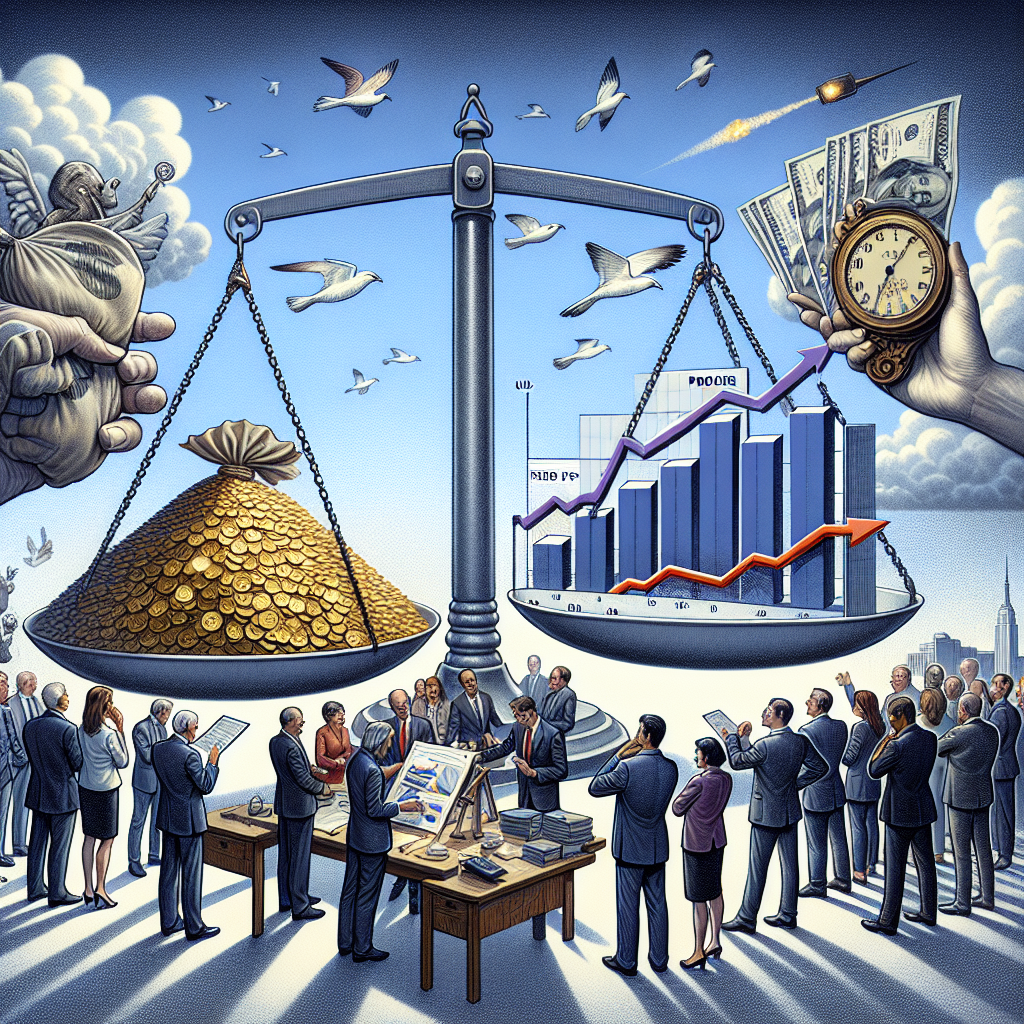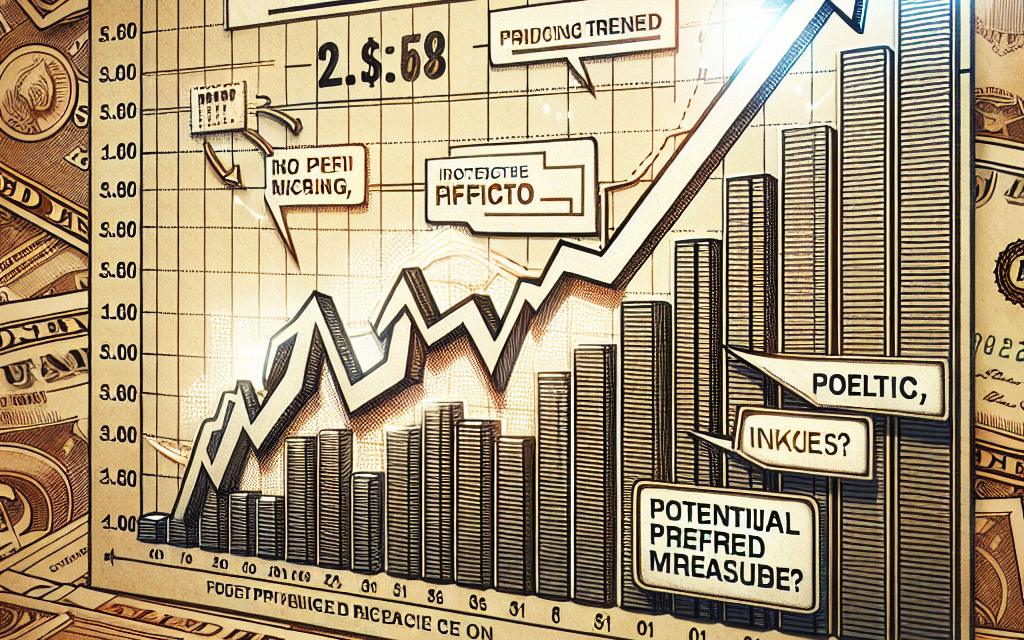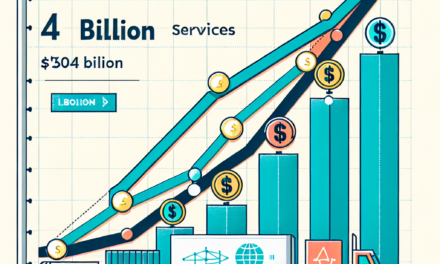“Rising Producer Prices: A New Challenge for the Fed’s Inflation Gauge”
Introduction
In recent economic developments, the United States has witnessed a notable increase in producer prices, a trend that could have significant implications for the Federal Reserve’s preferred measure of inflation. Producer prices, which reflect the cost of goods and services at the wholesale level, serve as a critical indicator of inflationary pressures within the economy. This uptick suggests that businesses are facing higher input costs, which may eventually be passed on to consumers, thereby influencing consumer price inflation. The Federal Reserve closely monitors these dynamics as it formulates monetary policy, particularly focusing on its preferred inflation gauge, the Personal Consumption Expenditures (PCE) Price Index. The rise in producer prices could signal upward pressure on the PCE, potentially impacting the Fed’s decisions regarding interest rates and other monetary policy tools aimed at maintaining economic stability and controlling inflation.
Understanding the US Producer Price Index and Its Economic Implications
The US Producer Price Index (PPI) is a critical economic indicator that measures the average change over time in the selling prices received by domestic producers for their output. As a reflection of inflation at the wholesale level, the PPI provides valuable insights into the economic landscape, influencing decisions made by policymakers, businesses, and investors alike. Recently, an increase in producer prices has garnered attention, raising questions about its potential impact on the Federal Reserve’s preferred measure of inflation, the Personal Consumption Expenditures (PCE) Price Index.
To understand the implications of rising producer prices, it is essential to first grasp the relationship between the PPI and the broader economic environment. The PPI is often seen as a leading indicator of consumer price inflation, as changes in wholesale prices can eventually trickle down to retail prices. When producers face higher costs, they may pass these costs onto consumers, leading to increased prices for goods and services. Consequently, a rise in the PPI can signal future inflationary pressures, prompting the Federal Reserve to consider adjustments in monetary policy to maintain economic stability.
The recent uptick in the PPI has sparked discussions about its potential effects on the PCE Price Index, the Fed’s preferred measure of inflation. The PCE Price Index differs from the Consumer Price Index (CPI) in that it accounts for changes in consumer behavior and provides a broader measure of inflation by including expenditures made on behalf of households, such as healthcare. The Fed closely monitors the PCE Price Index to gauge inflationary trends and make informed decisions regarding interest rates and other monetary policy tools.
As producer prices rise, the potential for these increases to be reflected in the PCE Price Index becomes a focal point for economic analysts. If higher producer prices lead to increased consumer prices, the PCE Price Index may also rise, indicating heightened inflationary pressures. This scenario could prompt the Federal Reserve to consider tightening monetary policy, such as raising interest rates, to curb inflation and ensure economic stability. However, the relationship between the PPI and the PCE Price Index is not always straightforward, as various factors can influence the transmission of wholesale price changes to consumer prices.
For instance, businesses may absorb some of the increased costs to remain competitive, thereby mitigating the impact on consumer prices. Additionally, supply chain dynamics, labor market conditions, and global economic factors can all play a role in determining how changes in producer prices affect the broader economy. Therefore, while a rise in the PPI can signal potential inflationary pressures, it is not the sole determinant of changes in the PCE Price Index.
In conclusion, the recent increase in US producer prices has significant implications for the economy, particularly concerning the Federal Reserve’s preferred measure of inflation, the PCE Price Index. As policymakers and economic stakeholders closely monitor these developments, understanding the nuances of the PPI and its relationship with consumer prices becomes crucial. By considering the various factors that influence the transmission of wholesale price changes to consumer prices, stakeholders can better anticipate potential shifts in monetary policy and their broader economic impact. As such, the PPI remains a vital tool for assessing inflationary trends and guiding economic decision-making in an ever-evolving landscape.
How Rising Producer Prices Could Influence Federal Reserve Policies
In recent months, the United States has witnessed a notable increase in producer prices, a development that could have significant implications for the Federal Reserve’s monetary policy. Producer prices, which measure the average change over time in the selling prices received by domestic producers for their output, serve as a critical indicator of inflationary pressures within the economy. As these prices rise, they can potentially influence the Federal Reserve’s preferred measure of inflation, the Personal Consumption Expenditures (PCE) price index, thereby impacting the central bank’s policy decisions.
The increase in producer prices can be attributed to several factors, including supply chain disruptions, rising commodity prices, and increased demand as the economy continues to recover from the pandemic-induced downturn. Supply chain disruptions, exacerbated by geopolitical tensions and lingering effects of the COVID-19 pandemic, have led to shortages of key materials and components, driving up costs for producers. Additionally, the surge in commodity prices, particularly in energy and raw materials, has further contributed to the upward pressure on producer prices. As demand for goods and services rebounds, producers are often able to pass on these higher costs to consumers, leading to broader inflationary trends.
The Federal Reserve closely monitors inflation indicators to guide its monetary policy decisions, with the PCE price index being its preferred measure. This index provides a comprehensive view of inflation by capturing changes in the prices of goods and services consumed by households. A sustained increase in producer prices could eventually translate into higher consumer prices, thereby influencing the PCE index. If the PCE index shows persistent inflationary pressures, the Federal Reserve may be compelled to adjust its policy stance to maintain price stability.
In response to rising inflation, the Federal Reserve might consider tightening its monetary policy by raising interest rates or reducing its asset purchase program. Higher interest rates can help temper inflation by increasing the cost of borrowing, thereby slowing down consumer spending and business investment. However, such measures also carry the risk of dampening economic growth, which is a delicate balance the Federal Reserve must navigate. The central bank’s dual mandate of promoting maximum employment and ensuring price stability requires careful consideration of the trade-offs involved in policy adjustments.
Moreover, the Federal Reserve’s communication strategy plays a crucial role in managing market expectations and ensuring a smooth transition in policy. Clear and transparent communication can help mitigate market volatility and provide guidance to businesses and consumers as they make financial decisions. As the Federal Reserve assesses the implications of rising producer prices, it will likely emphasize its commitment to data-driven decision-making and its readiness to adapt its policy tools as necessary.
In conclusion, the recent increase in US producer prices presents a potential challenge for the Federal Reserve as it seeks to balance its dual mandate. The interplay between producer prices and the PCE index underscores the complexity of the inflation landscape and the importance of vigilant monitoring by policymakers. As the Federal Reserve navigates these dynamics, its policy decisions will be crucial in shaping the economic outlook and ensuring a stable and sustainable recovery. The coming months will be pivotal in determining how rising producer prices influence the broader inflationary environment and the Federal Reserve’s response to these evolving economic conditions.
The Relationship Between Producer Prices and Consumer Inflation
In recent months, the dynamics of the U.S. economy have been closely scrutinized, particularly in light of the rising producer prices that have the potential to influence the Federal Reserve’s preferred measure of inflation. Producer prices, which reflect the cost of goods and services at the wholesale level, serve as a critical indicator of future consumer inflation. As these prices increase, they often signal that higher costs may eventually be passed on to consumers, thereby affecting the overall inflation rate.
The relationship between producer prices and consumer inflation is complex, yet fundamentally interconnected. When producers face higher input costs, whether due to increased raw material prices, labor costs, or supply chain disruptions, they are often compelled to adjust their pricing strategies. This adjustment can lead to higher prices for finished goods and services, which consumers ultimately encounter in the marketplace. Consequently, a rise in producer prices can foreshadow an uptick in consumer inflation, a scenario that policymakers and economists vigilantly monitor.
The Federal Reserve, tasked with maintaining economic stability, closely observes these trends as part of its mandate to control inflation. The Fed’s preferred measure of inflation, the Personal Consumption Expenditures (PCE) Price Index, is particularly sensitive to changes in producer prices. This index provides a comprehensive view of how price changes affect consumer spending, and it is considered a more accurate reflection of inflationary pressures than other measures, such as the Consumer Price Index (CPI). As producer prices climb, the PCE Price Index may also rise, prompting the Fed to consider adjustments to its monetary policy.
In this context, the recent increase in U.S. producer prices has garnered significant attention. Several factors have contributed to this upward trend, including supply chain bottlenecks, geopolitical tensions, and fluctuating energy prices. These elements have collectively exerted pressure on producers, leading to higher costs that are likely to be transferred to consumers. As a result, the potential impact on the PCE Price Index becomes a focal point for economic analysis and policy deliberation.
Moreover, the implications of rising producer prices extend beyond immediate inflationary concerns. They also influence business investment decisions, consumer confidence, and overall economic growth. Businesses facing higher production costs may delay or reduce investment in new projects, which can have a ripple effect on job creation and economic expansion. Similarly, consumers confronted with rising prices may alter their spending habits, opting to save more and spend less, which can dampen economic activity.
In response to these developments, the Federal Reserve may find itself at a crossroads. On one hand, it must weigh the need to curb inflation by potentially raising interest rates, a move that could slow economic growth. On the other hand, it must consider the broader economic landscape, including employment levels and global economic conditions, before making any policy adjustments. This delicate balancing act underscores the complexity of managing an economy in which producer prices play a pivotal role.
In conclusion, the increase in U.S. producer prices is a significant development with far-reaching implications for consumer inflation and the Federal Reserve’s monetary policy. As these prices continue to rise, they serve as a harbinger of potential changes in the economic environment, necessitating careful analysis and strategic decision-making by policymakers. The intricate relationship between producer prices and consumer inflation remains a critical area of focus, shaping the economic discourse and influencing the path forward for the U.S. economy.
Analyzing the Impact of Producer Price Increases on the US Economy

In recent months, the United States has witnessed a notable increase in producer prices, a development that could have significant implications for the broader economy. Producer prices, which measure the average change over time in the selling prices received by domestic producers for their output, serve as a critical indicator of inflationary pressures within the economy. As these prices rise, they can potentially influence the Federal Reserve’s preferred measure of inflation, the Personal Consumption Expenditures (PCE) price index, thereby impacting monetary policy decisions.
To understand the potential ramifications of rising producer prices, it is essential to consider the underlying factors contributing to this trend. Several elements have converged to drive up producer prices, including supply chain disruptions, increased demand for goods, and higher input costs. Supply chain disruptions, exacerbated by the lingering effects of the COVID-19 pandemic, have led to shortages of key materials and components, thereby increasing production costs. Concurrently, as the economy continues to recover, demand for goods has surged, further straining supply chains and contributing to price increases.
Moreover, higher input costs, particularly in energy and raw materials, have played a significant role in elevating producer prices. Energy prices, for instance, have been on an upward trajectory due to geopolitical tensions and production cuts by major oil-producing nations. These increased costs are often passed on to consumers, thereby contributing to inflationary pressures. As producer prices rise, businesses may face the difficult decision of whether to absorb these costs or pass them on to consumers in the form of higher prices for goods and services.
The potential impact of rising producer prices on the Federal Reserve’s preferred measure of inflation, the PCE price index, is a matter of considerable interest. The PCE price index is a comprehensive measure that reflects changes in the prices of goods and services consumed by households. It is favored by the Federal Reserve because it accounts for changes in consumer behavior and provides a more accurate reflection of inflationary trends. As producer prices increase, there is a risk that these higher costs will be transmitted to consumers, thereby exerting upward pressure on the PCE price index.
In response to rising inflationary pressures, the Federal Reserve may consider adjusting its monetary policy stance. Traditionally, the central bank aims to maintain price stability by targeting a 2% inflation rate over the long term. If inflation, as measured by the PCE price index, consistently exceeds this target, the Federal Reserve may opt to raise interest rates to cool down the economy and curb inflation. However, such a move could have broader economic implications, potentially slowing down economic growth and affecting employment levels.
In conclusion, the recent increase in US producer prices is a development that warrants close attention due to its potential impact on the broader economy. As supply chain disruptions, increased demand, and higher input costs continue to drive up producer prices, there is a risk that these pressures will be transmitted to consumers, thereby influencing the Federal Reserve’s preferred measure of inflation. Consequently, policymakers and market participants alike will be closely monitoring these trends to assess their implications for monetary policy and the overall economic outlook. As the situation evolves, it will be crucial to strike a balance between addressing inflationary pressures and supporting economic growth.
Potential Consequences of Producer Price Hikes on Interest Rates
The recent increase in US producer prices has garnered significant attention, as it may have far-reaching implications for the Federal Reserve’s monetary policy, particularly concerning interest rates. Producer prices, which measure the average change over time in the selling prices received by domestic producers for their output, serve as a critical indicator of inflationary pressures within the economy. When these prices rise, it often signals that inflation may be on the horizon, potentially prompting the Federal Reserve to adjust its interest rate policies to maintain economic stability.
To understand the potential consequences of rising producer prices, it is essential to consider the relationship between these prices and the Federal Reserve’s preferred measure of inflation, the Personal Consumption Expenditures (PCE) Price Index. The PCE Price Index is a comprehensive measure that reflects changes in the prices of goods and services consumed by households. It is favored by the Federal Reserve because it accounts for changes in consumer behavior and provides a more accurate reflection of the cost of living. When producer prices increase, it can lead to higher costs for businesses, which may eventually be passed on to consumers in the form of higher retail prices, thereby influencing the PCE Price Index.
As producer prices climb, businesses face the challenge of managing increased production costs. Some companies may absorb these costs to maintain competitive pricing, while others may pass them on to consumers, leading to higher prices for goods and services. This potential increase in consumer prices can contribute to inflationary pressures, which the Federal Reserve closely monitors. If inflation rises above the Fed’s target rate, typically around 2%, it may prompt the central bank to consider raising interest rates to curb spending and borrowing, thereby cooling down the economy.
Moreover, the impact of rising producer prices on interest rates is not limited to domestic considerations. In a globalized economy, changes in US interest rates can have ripple effects across international markets. Higher interest rates in the US can attract foreign investment, leading to an appreciation of the US dollar. While a stronger dollar can benefit American consumers by making imported goods cheaper, it can also pose challenges for US exporters by making their products more expensive for foreign buyers. This dynamic can influence trade balances and economic growth, further complicating the Federal Reserve’s decision-making process.
In addition to these economic factors, the Federal Reserve must also consider the broader context in which these price changes occur. Supply chain disruptions, geopolitical tensions, and shifts in consumer demand can all contribute to fluctuations in producer prices. The Fed’s response to rising producer prices will likely depend on a comprehensive assessment of these factors, as well as the overall health of the economy.
In conclusion, the increase in US producer prices has the potential to impact the Federal Reserve’s preferred measure of inflation, the PCE Price Index, and subsequently influence interest rate decisions. As businesses navigate higher production costs, the possibility of inflationary pressures looms, prompting the Fed to carefully evaluate its monetary policy stance. The interconnectedness of global markets further complicates this decision-making process, highlighting the importance of a nuanced approach to managing economic stability. As such, the Federal Reserve’s response to rising producer prices will be a critical factor in shaping the future trajectory of interest rates and the broader economy.
The Role of Producer Prices in Shaping Monetary Policy Decisions
In recent months, the dynamics of producer prices in the United States have garnered significant attention, particularly in the context of their potential impact on monetary policy decisions. Producer prices, which reflect the average change over time in the selling prices received by domestic producers for their output, serve as a critical indicator of inflationary pressures within the economy. As these prices increase, they can signal rising costs for businesses, which may eventually be passed on to consumers, thereby influencing the broader inflation landscape. This development is particularly pertinent as it may affect the Federal Reserve’s preferred measure of inflation, the Personal Consumption Expenditures (PCE) Price Index.
The PCE Price Index is favored by the Federal Reserve due to its comprehensive coverage and ability to account for changes in consumer behavior. It provides a more accurate reflection of the inflationary pressures faced by consumers compared to other measures, such as the Consumer Price Index (CPI). Consequently, any significant shifts in producer prices can have a cascading effect on the PCE, potentially prompting the Federal Reserve to reassess its monetary policy stance. This is especially relevant in the current economic climate, where the central bank is navigating the delicate balance between fostering economic growth and curbing inflation.
As producer prices rise, businesses may face increased input costs, which can erode profit margins if not managed effectively. In response, companies might opt to pass these costs onto consumers in the form of higher prices for goods and services. This, in turn, can contribute to an uptick in consumer inflation, as captured by the PCE Price Index. Should this trend persist, it could compel the Federal Reserve to consider tightening monetary policy to prevent the economy from overheating. Such measures might include raising interest rates or tapering asset purchases, both of which are designed to temper inflationary pressures by reducing consumer spending and borrowing.
However, it is essential to recognize that the relationship between producer prices and consumer inflation is not always straightforward. Various factors, such as supply chain disruptions, labor market conditions, and global economic trends, can influence the extent to which changes in producer prices translate into consumer price inflation. For instance, if businesses are able to absorb higher input costs through efficiency gains or by leveraging economies of scale, the impact on consumer prices may be muted. Conversely, in a tight labor market where wage pressures are mounting, businesses may have less flexibility to absorb cost increases, thereby amplifying the transmission of producer price inflation to consumers.
Moreover, the Federal Reserve’s response to rising producer prices is contingent upon its assessment of the broader economic context. The central bank must weigh the potential risks of inflation against the need to support economic recovery, particularly in the aftermath of the COVID-19 pandemic. This necessitates a nuanced approach to monetary policy, one that is informed by a comprehensive analysis of various economic indicators, including employment data, consumer spending patterns, and global economic developments.
In conclusion, the recent increase in US producer prices has significant implications for monetary policy decisions, particularly in relation to the Federal Reserve’s preferred measure of inflation, the PCE Price Index. As the central bank navigates the complexities of the current economic environment, it must carefully consider the interplay between producer prices and consumer inflation, while remaining vigilant to the myriad factors that can influence this relationship. Ultimately, the Federal Reserve’s ability to effectively manage inflationary pressures will be crucial in ensuring sustained economic growth and stability.
Strategies for Businesses to Mitigate the Effects of Rising Producer Prices
As the US economy continues to navigate the complexities of post-pandemic recovery, businesses are increasingly facing the challenge of rising producer prices. This trend, which has the potential to impact the Federal Reserve’s preferred measure of inflation, necessitates strategic responses from companies aiming to mitigate its effects. Understanding the underlying causes of these price increases is crucial for developing effective strategies. Supply chain disruptions, labor shortages, and increased demand for raw materials are among the primary drivers of rising producer prices. Consequently, businesses must adopt a multifaceted approach to address these challenges.
One effective strategy is to enhance supply chain resilience. By diversifying suppliers and sourcing materials from multiple regions, companies can reduce their vulnerability to disruptions in any single area. Additionally, investing in technology to improve supply chain visibility can help businesses anticipate potential bottlenecks and respond proactively. For instance, advanced analytics and real-time data tracking can provide insights into inventory levels and lead times, enabling more informed decision-making.
Moreover, businesses should consider revisiting their pricing strategies. While passing on increased costs to consumers may seem like an immediate solution, it is essential to balance this approach with maintaining customer loyalty and competitive positioning. Implementing dynamic pricing models that adjust based on market conditions can help companies remain agile. Furthermore, offering value-added services or bundling products can enhance perceived value, allowing for price adjustments without alienating customers.
In addition to pricing strategies, cost management remains a critical focus. Streamlining operations to improve efficiency can offset some of the pressures from rising input costs. This might involve adopting lean manufacturing principles, optimizing production processes, or investing in automation to reduce labor expenses. By identifying areas where waste can be minimized, businesses can achieve cost savings that help buffer against external price increases.
Another avenue for mitigating the impact of rising producer prices is through strategic partnerships and collaborations. By working closely with suppliers, businesses can negotiate better terms or explore joint ventures that benefit both parties. Collaborative efforts can also extend to research and development, where companies can share resources to innovate and create cost-effective solutions. Such partnerships not only help in managing costs but also foster a sense of shared purpose and resilience.
Furthermore, businesses should not overlook the importance of financial planning and risk management. Hedging against price volatility through financial instruments can provide a safety net, allowing companies to stabilize costs over time. Additionally, maintaining a robust cash flow and liquidity position ensures that businesses can weather short-term fluctuations without compromising long-term objectives.
Finally, it is imperative for businesses to stay informed about economic trends and policy changes. Engaging with industry associations, attending conferences, and subscribing to relevant publications can provide valuable insights into market dynamics. By staying abreast of developments, companies can anticipate shifts in producer prices and adjust their strategies accordingly.
In conclusion, while rising producer prices present significant challenges, they also offer an opportunity for businesses to innovate and strengthen their operations. By adopting a comprehensive approach that includes supply chain resilience, pricing strategies, cost management, strategic partnerships, and financial planning, companies can effectively mitigate the impact of these increases. As the economic landscape continues to evolve, businesses that remain adaptable and proactive will be better positioned to thrive in the face of uncertainty.
Q&A
1. **What are US Producer Prices?**
– US Producer Prices refer to the average change over time in the selling prices received by domestic producers for their output. It is a key indicator of inflation at the wholesale level.
2. **How do Producer Prices impact inflation?**
– An increase in producer prices can lead to higher consumer prices as businesses may pass on the higher costs to consumers, contributing to inflation.
3. **What is the Fed’s preferred measure of inflation?**
– The Federal Reserve’s preferred measure of inflation is the Personal Consumption Expenditures (PCE) Price Index, which reflects changes in the prices of goods and services consumed by households.
4. **How might rising producer prices affect the PCE Price Index?**
– Rising producer prices can lead to higher costs for goods and services, which may eventually be reflected in the PCE Price Index, indicating increased inflationary pressures.
5. **Why is the Fed concerned about inflation?**
– The Fed is concerned about inflation because it can erode purchasing power, create uncertainty in the economy, and potentially lead to higher interest rates, affecting economic growth.
6. **What actions might the Fed take if producer prices continue to rise?**
– If producer prices continue to rise and contribute to higher inflation, the Fed might consider tightening monetary policy, such as raising interest rates, to control inflation.
7. **What are the potential economic impacts of increased producer prices?**
– Increased producer prices can lead to higher consumer prices, reduced consumer spending, and potential slowdowns in economic growth if inflation becomes too high and persistent.
Conclusion
In recent months, the increase in US producer prices has raised concerns about its potential impact on the Federal Reserve’s preferred measure of inflation, the Personal Consumption Expenditures (PCE) Price Index. As producer prices rise, the cost of goods and services at the wholesale level increases, which can eventually be passed on to consumers, leading to higher consumer prices. This upward pressure on prices could influence the PCE Price Index, which the Fed closely monitors to gauge inflationary trends. If the PCE index reflects sustained inflation above the Fed’s target, it may prompt the central bank to consider tightening monetary policy through interest rate hikes or other measures to curb inflation. Therefore, the increase in producer prices could have significant implications for the Fed’s monetary policy decisions and the broader economic outlook.





